Finessing Fiber
There has been considerable discussion about how to better converge the optical transport layer with the switching and routing layers to increase network efficiency and lower costs. Some technologists suggest the optical-transport-layer functions should migrate directly into switches or routers, while others argue that Layer Two switching and even Layer Three routing capabilities should migrate directly into optical add/drop multiplexers (OADMs).
In either approach, there is a generally recognized need to increase the intelligence of the network itself and to provide a higher degree of coupling between the optical layer (Layer One) and the switching and routing layers (Layers Two and Three) to achieve a higher degree of network automation and efficiency. This then benefits cable operators with lower opex and capex costs during the life of the network.
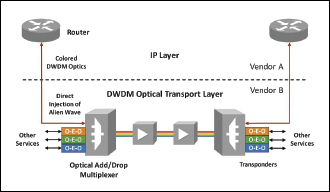 |
| FIGURE 1: Router interconnection using native and alien wavelengths ( all figures courtesy of Infinera) |
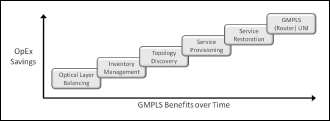 |
| FIGURE 2: GMPLS automation of optical transport functions. |
Those who believe the optical-layer functions should migrate into the switching and routing layers frequently promote IPo-DWDM as a solution (IP over DWDM, also referred to as “alien wave” optical IP networks). Essentially, IPoDWDM moves the DWDM transponder from the OADM and integrates it directly into a router port, thus eliminating a pair of short-reach client optical interfaces ( see Figure 1). In this case, the original OADM network remains in place to carry other IP and non-IP services and to provide an optical line system (optical multiplexers/demultiplexers, amplifiers, etc.) for the DWDM waves originating on the routers. Because the router’s DWDM waves now are carried on an optical transport layer typically provided by another vendor, they often are referred to as “alien” waves.
Proponents of IPoDWDM believe it reduces capex costs and creates an efficient, unified network by integrating the IP layer with the optical layer in the router. If a suitable control plane is shared between the routers and OADMs, it is possible for the routers to participate in wavelength routing and management by communicating with the OADMs, though this generally is not the case without an industry-standardized control plane defined for alien waves and shared by both the OADM and the router. However, some vendors offer proprietary solutions that support this capability.
Proponents of migrating higher-layer switching functions into OADMs believe additional network efficiencies may be gained by using router bypass at the optical layer to reduce the number of router ports and to relieve the amount of traffic handled by each router. In this case, rather than using intermediate routers to forward traffic to its final destination, the optical layer is used to create a DWDM mesh network that interconnects the end routers at the optical layer, thus allowing traffic to be forwarded directly between router pairs.
Arguments readily can be made to support both IPoDWDM and router bypass perspectives, and MSOs have deployed both architectures. Recent advances in optical-transport technology have begun to impact the debate regarding IPoDWDM and router bypass, notably the increasing intelligence of optical networks using GMPLS and the advent of large-scale photonic integration, which makes it possible to integrate almost all the DWDM optical subsystems for multiple lambdas on a single photonic IC (PIC).
GMPLS, an industry-standard control plane, allows network elements to communicate directly with one another to automate and to optimize a wide range of network functions. GMPLS already is utilized in some OADMs to provide a high degree of network intelligence and automation, including automated optical-layer balancing, inventory discovery and management, topology discovery, service provisioning and service restoration. These provide ongoing opex savings by automating formerly manual processes and by accelerating service delivery ( see Figure 2).
GMPLS opens the door to tighter optical and IP layer coupling through a User Network Interface (UNI) that extends the control plane from the optical layer to the switching and routing layers. A GMPLS UNI interface between an OADM and a router allows the router to request bandwidth from the OADM, which then routes and provisions the wavelengths and services. GMPLS UNI interoperability extends the benefits of GMPLS to a multi-vendor network, and it supports router-requested bandwidth on demand.
PICs enable economical optical-electrical-optical (OEO) conversions on OADMs for the first time, and this allows a digital switch to be cost-effectively integrated directly into the OADM, creating a digital ROADM (reconfigurable OADM) that processes and switches signals digitally instead of just optically. Enabled with GMPLS, digital ROADMs allow the deployment of digital optical networks that provide a degree of flexibility not possible with all-optical networks.
IPoDWDM Considerations
DWDM networks are built on the ability of OADMs to transport optical signals transparently on different wavelengths on a common optical fiber. DWDM transport systems and their components are designed to provide optimum performance as an integrated system with a common set of design rules. The DWDM waves on OADMs are created by transponders or PIC line modules, which optimize transport performance by using a common set of attributes and design rules to address forward error correction (FEC), reach, OSNR, optical power levels, dispersion and other optical parameters. This helps to ensure a high level of overall performance for the system as a whole. These systems are deployed widely, and they have a successful track record for delivering reliable services in metro, regional and long-haul networks.
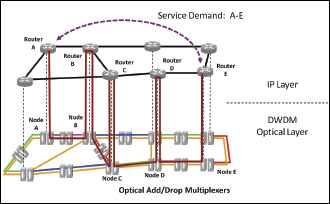 |
| FIGURE 3: Conventional core IP network architecture. |
With alien-wave deployment, a router directly injects DWDM waves into an existing DWDM transport network. At first glance, alien waves appear to offer capex savings via a reduction of the total number of optical interconnects required. In an ideal situation, this might be the case. However, the complexity of modern optical-transmission systems, especially those that operate over regional/long-haul distances and at high bit rates, means many challenges remain in alien-wave deployment; standards for alien wave data plane interoperability at the optical layer do not exist today.
Alien waves represent an independent DWDM network sharing the same fiber and line system as an existing DWDM network. This may require interactive, parallel designs to arrive at an optical-layer configuration that helps ensure proper performance of the alien and native waves across OSNR, PMD, CD and other optical parameters.
Different optical modulation formats, bit rates and FEC coding also are factors that must be addressed. The end result can be a lowest-common-denominator network, where the weakest link in the design sets the base performance level for the network as a whole. This may actually result in higher capex costs, for example, if additional amplifiers or re-gen sites are required to accommodate alien waves. Alien waves may also require additional manual operations to install, balance, turn up and maintain. This can increase opex costs and delay service delivery.
Because alien-wave transport often largely is invisible to the primary transport system, there may be limited or no support for alien-wave performance monitoring, fault localization or protection switching on the primary system. Similarly, the primary system usually is invisible to the alien wave NE. This makes it virtually impossible for the systems to share closed control loops that might serve to automate network operations and to provide intelligent management and monitoring of the network as a whole.
Operational complexity also may be increased if separate management systems and provisioning/monitoring operations are required. While a GMPLS control plane, if ever standardized for alien-wave applications, would help mitigate these problems, the operator essentially continues to run two separate DWDM networks on a common optical layer.
Router Bypass Thoughts
In a conventional IP network architecture, routers primarily are interconnected with others that are topologically adjacent on the transport network ( see Figure 3). These routers are connected at the optical layer by OADMs co-located at the router nodes, while a logical mesh network is created primarily at Layer Three. IP traffic flowing from Router A to E, for example, must transit through Routers B through D to reach its final destination. This places additional traffic demand on the intermediate routers, which now must handle their own service requirements as well as those of adjacent routers whose traffic is solely pass-through. In this case, a significant portion of the IP and transport-network investment is used only for pass-through traffic, which easily may be 40 percent to 60 percent of the load. This often is the case in CATV architectures, where a hub router at a headend or primary hub serves many other routers on subtended rings.
Using a router bypass architecture ( see Figure 4), a mesh network connecting router pairs is created primarily at the optical layer, allowing IP traffic to be carried directly between the end-router pairs and relieving the intermediate routers of this burden. In this case, for example, the service demand between Routers A and E now is carried at the optical layer directly between the routers. Router bypass makes efficient use of network resources and actually can reduce the number of transponders and router interfaces required or at least allow lower-cost, lower-speed interfaces to be used. Processing traffic at the optical layer generally is less expensive than at the routing layer.
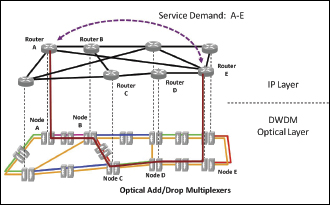 |
| FIGURE 4: Core IP network architecture with router bypass. |
Router bypass may be implemented in the optical network using IPoDWDM, all-optical ROADMs or digital ROADMs. However, the first two of these options only permit router bypass at the optical layer and only with wavelength granularity. Digital ROADMs, depending on their configuration, can support router bypass at the optical layer (using OTN switching) or at the digital layer (using Ethernet packet switching); they are not subject to the all-optical limitations of the other approaches.
Digital ROADMs, which perform OEO conversions for every lambda at every node, provide digital switching for every service at every node. This architecture, known as bandwidth virtualization, creates a pool of bandwidth in the transport layer on every span; services then are digitally allocated bandwidth from this pool as they are turned up. Services are fully switched in the digital domain at each node and are, therefore, decoupled from specific waves.
Digital ROADMs are colorless and directionless: any service entering the digital ROADM node may be switched to any outgoing line wave or to any add/drop port. They provide other operational benefits as well, such as the ability to sectionalize faults, because digital performance monitoring of BER and other parameters is available for every service at every node.
At each node, digital ROADMs support lambda switching, sub-lambda grooming, and inter-lambda switching, which all-optical ROADMs cannot support without additional intermediate transponders, and which IPoDWDM cannot support at all because alien waves by definition remain in the optical domain between routers. Unlike all-optical solutions that strictly couple services to waves and that only can switch whole waves, digital ROADMs optimize wave utilization by grooming services individually onto each wave. They virtually eliminate wavelength blocking by inter-lambda switching. This improves overall network efficiency while lowering capex costs.
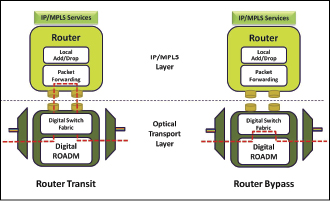 |
| FIGURE 5: Router transit and router bypass configurations with a digital ROADM. |
FIGURE 4: Core IP network architecture with router bypass.
Digital ROADMs support router bypass at the optical layer with an integrated OTN switch and a GMPLS control plane that provides end-to-end automated routing and provisioning of services. This allows router bypass to be configured easily whenever needed ( see Figure 5). If a GMPLS UNI interface is incorporated in the control plane, the routers themselves may dynamically configure on-demand bandwidth, offering a high degree of integration between the optical and IP layers.
Digital ROADMs also can support Layer Two switching if a packet fabric is implemented in the ROADM instead of or in addition to the OTN fabric. With an integrated Ethernet MPLS switch, router bypass may be implemented efficiently at Layer Two, significantly reducing the number of router ports and transponders required. This approach creates a dynamic Layer Two switching architecture residing in the digital optical network between the optical and IP layers, but without the need for external third-party switches. Following the proscription of “route once, switch many,” which allocates network processing to the lowest-possible-cost layer, this architecture combines maximum flexibility with overall lower costs.
What It All Means
The advent of PICs, the wider adoption of GMPLS and the emergence of all-digital OTN switching has changed the dynamics on how best to achieve greater integration between the optical layer and the layers above it. Modern digital ROADMs that integrate all three of these in a single platform allow new digital optical networks to provide a higher degree of inter-layer coupling and with greater flexibility than can be accomplished with all-optical IPoDWDM and ROADM solutions.
Gaylord Hart is director/MSO Market Segment at Infinera. Contact him at ghart@infinera.com.